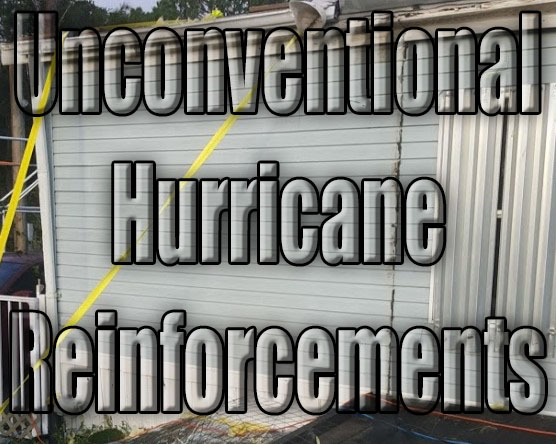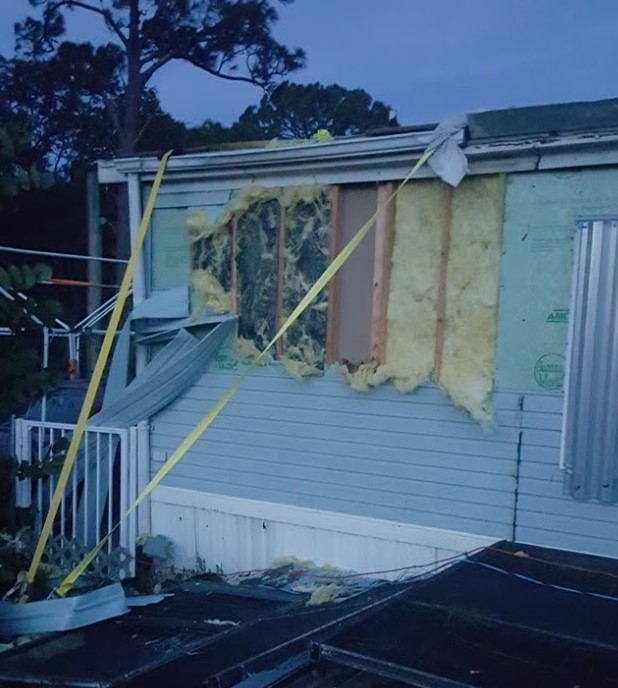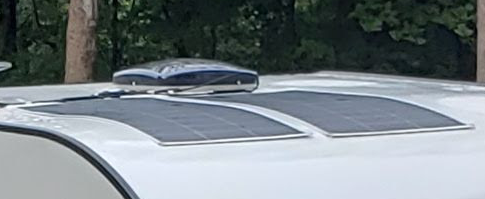I’m not alone in my prepping attitude. A news article I recently read indicated that there is a growing fear among people that some disaster is coming and more people than ever are thinking of the “What if?”. The disasters people were concerned about ranged from global recessions to terrorism to weather.

In Florida and most of the East Coast of the US, the disasters in mind are hurricanes. Hurricanes are “good” disasters, because you have time to prepare in general. The usual way to protect your home and family include moving and securing anything outdoors and covering your windows. We have tornadoes too and some of these “reinforcements” could help keep your family and your home safe year round.
Before I truly begin, I must of course disclose that these are just my experiential and circumstantial ideas. When if comes to the safety of your family and your belongings, you should take no shortcuts, you should hire a licensed engineer and/or contractors to perform any work on your home, you should carry as much insurance as recommended, and you probably should not trust the opinion of one random person on the internet. In short, I think these are good ideas, but they may not be . . . seek the opinion of a professional licensed in your state before you make any decisions about the safety of your family or stuff.
Now, I live in a manufactured home only 10 miles off the coast that sits off the ground on concrete blocks AND we don’t have insurance. Yeah, I know, you think that is irresponsible, BUT . . . the house is essentially not insurable (Premiums are so high we could buy a new house every 3 years). Instead, we have saved money for any major repairs that need to be made or to be used as a down payment for new construction should the house be too far gone to repair.
I don’t want my house to blow away in a hurricane or tornado because I could lose all my memories and stuff. A new house would cost much more in taxes and we would likely need to have a mortgage again. I have lots of reasons to protect my house and have done a few things I think are quite brilliant and a few which probably don’t really do much, but I’m excited to share my ideas and I hope they might inspire someone. (Even with the below modifications, I would never risk my family in a storm — Please evacuate if such is recommended by your local authorities).
Roof Straps for Hurricane
I have seen this as an actual commercial project. The major weak point of many homes is the connection between the roof and the walls. A hurricane or tornado blows through and lifts or rips the roof right off the home. This is almost a guarantee if a window blows out and you don’t have a covering on it.

For my home, I believe this modification actually saved my roof and my home when Hurricane Irma lifted and ripped off our back porch — throwing it over the house and into the front yard.
- Things I used:
- 27 Foot 3000 lb, 10000 lb breaking Strength 2 in Ratchet straps ( I used 8)
- 5 ft Ground Anchor (I used 8 similar to the one in the link, though mine were 60 inches from a local hardware store for strongest pull our force)
- Scrap Wood
- Scrap Clothes
The ratchet straps have a 10000 pound breaking strength. The length of the ground anchor and how hard it will be to insert depends on the soil around your home. You could dig a hole and then back fill the hole, but this will create a weak anchor. It is best if “twisted in” as it is intended. I used a steel pole to gain the needed leverage and put it in as deep as a could (It was hard!) Companies that specialize in anchoring have a tool that can drive the anchor for you.
Two ratchet straps stretched from one anchor, over my room and down to the anchor on the other side of the house. At the roof edge I placed a 4 or 5 foot used deck plank to spread the force across the edge of the roof. This is important or you may damage your roof when you tighten the straps.
When the wind from the hurricane begins, it will whip and vibrate the straps and possibly damage your roof! I solved this with our “rag bag” –old clothes wrapped and knotted around as many contact points as I can. I put one at the edges of the roof, the apex, and at least one spot between the top and sides of the roof. I’m sure the professional roof strap people, have some kind of plastic blocks that lift the strap off your roof.
I place the anchors a few feet out from the house in convenient locations since there will be metal sticking out of the ground and I don’t want to run that over with the mower. The straps take up very little space. With an assistant (which you should have because you’ll be on a roof!) this only takes about an hour to setup in preparation for the hurricane.
If I cover my windows with hurricane shelters, I also use the roof straps.
Safe Rooms for Hurricanes
I have never seen a safe room specifically designed for a hurricane, but our local extension office has one in our local “Hurricane House” that demonstrates many different hurricane prep ideas. The manufacturers claim they are only to be used for tornadoes.
Okay, tornadoes happen during hurricanes and these shelters are rated for 250 mph winds. My family bought a huge one and personally we intend to use it during hurricanes, emergencies like home invasions or tornadoes, and even just a quiet place to hang out some times.
There are several ways to put a safe room in your house, but for a DIYer, whom I suspect are the people reading this, a steel bolt together one is great option. Steel hurricane tornado shelters have thin walls compared to concrete, and the floor size can be changed with the addition or removal of sections. BEST OF ALL, since this is a several thousand dollar investment, you can choose to take it with you if you move.
In our case, we eventually expect to build a new house, and we wanted the shelter to be portable. We bought a huge version that we can put 3 blow up mattresses in, but here is the model that we purchased in smallest and largest size:
- Swisher SR84X039G ESP Safety Shelter (7×3 foot)
- Swisher SR84X144G ESP Safety Shelter (7×12 foot)
- These are affiliate links to Amazon . . . if you do purchase one of these from Amazon, please come back and use my link to do so. This does not change the price to you at all but sends a small percentage of Amazon’s profit to help maintain this site.
- That said, you can find this cheaper from other places where this site won’t benefit, but hey, this site is about DIY and saving money so cheers to ya! We found the big one at Sams club with free freight delivery (4 palettes totally over 4000lbs total) for $7000 on sale.
Installation was not very difficult, but there are many technical things you need to know about your foundation and the placement of the shelter on the foundation. The individual pieces are manageable alone, but the door is close to 250 lbs and really requires a second person. Also you are supposed to have your local permitting office or engineering certify that you met the requirements of the installation.
At 6′ 1″, I can stand in it without hitting my head and we put carpet down to decrease the echo. They also sell gun racks and other items you can add on. The kids really enjoy going in to read books because it is very quiet, quiet like when the power goes out. It is really quite pleasant.
Skirting Reinforcement for Hurricane Force Winds
We are not the original owners of our house and it is obvious that during the Francis and Jeane Hurricanes, our skirting was blown out. It is obvious because our house is slightly out of level, the air ducts had been replaced with the incorrect size and some of the foundation pillars had been modified.

We are fortunate that our house was built when building code required hurricane anchors, but that code doesn’t say anything about skirting. Common skirting is plastic or metal that is easily damaged or pushed in, often just resting in some J-channels. The last thing I want is 100mph+ hurricane winds and rain washing away our foundation for hours . . .
My solution to this that makes me feel better was to create a line of concrete blocks behind the bottom of the skirting and to fasten the bottom to the concrete block and the top to the house.
- List of Supplies
- Concrete Block from local supply yard
- Concrete Screws
- Hammer Drill (required to drill into concrete, don’t push hard or you’ll crack the concrete blocks)
- Wood Screws (I like to use roofing screws that come with a washer preinstalled)
- Fender Washers (To spread the force across the skirting)
Don’t tighten the concrete screws too hard or you may crack the block.
This reinforcement does make it more time consuming to go under the house for maintenance reasons, but I’ll pay that price for some piece of mind.
Hurricane Reinforcement Around Your Yard
This is where things get a bit questionable, but make sense to me.
Trees! Certain trees are more hurricane resistant than others. Live Oaks, Bald Cypress, and Slash pines are generally considered more resistant than other trees. I feel like people with bare lawns are going to get the worst winds, but also are not risking damage from limbs . . .
The idea and my plan here if you have the land, is to plant trees in a smart way. The worst winds seem to come from the coast, east in my case. I have planted trees that are hurricane resistant in hopes to lower the wind speed that reaches my home.
- Here are some things to think about before planting:
- Type of tree (Trees that can withstand Hurricanes)
- When fully grown, could the tree or a limb from the tree fall and damage the house
- Grouping trees will increase wind resistance
- Do you have soil depth for good rooting?
- Proximity to power lines
Reinforcing Trees
If you’ve spent some time browsing the rest of this web site, you’ll notice that I have a lot of trees, many of them young. Don’t forget to reinforce any young trees with bamboo shoots or other anchors as needed.
If you are also growing a food forest as I am, then as your forest grows it should provide a reduction in wind speeds that reach your home.
Likely not much help at all, but maybe don’t mow your lawn before the storm? My neighbor laughed when I suggested this one, but the grass should be able to absorb more water will maybe even reduce the speed of wind reaching your house by a fractional mph.
Conclusion
You should also consider the more conventional means of reinforcing your home against hurricanes, such as retrofitting your roof with hurricane straps, upgrading windows, doors, and shutters.
I do hope, however, that my ideas and opinions in regards to reinforcing your home may help to prevent a little bit of property damage for someone somewhere, or at the very least provide a bit of piece of mind. Always consult a professional before modifying your home!





